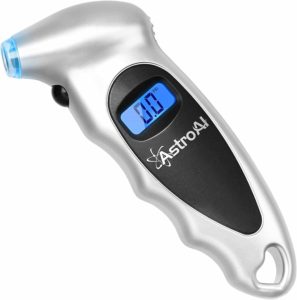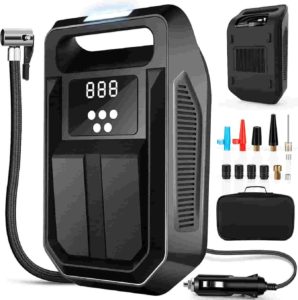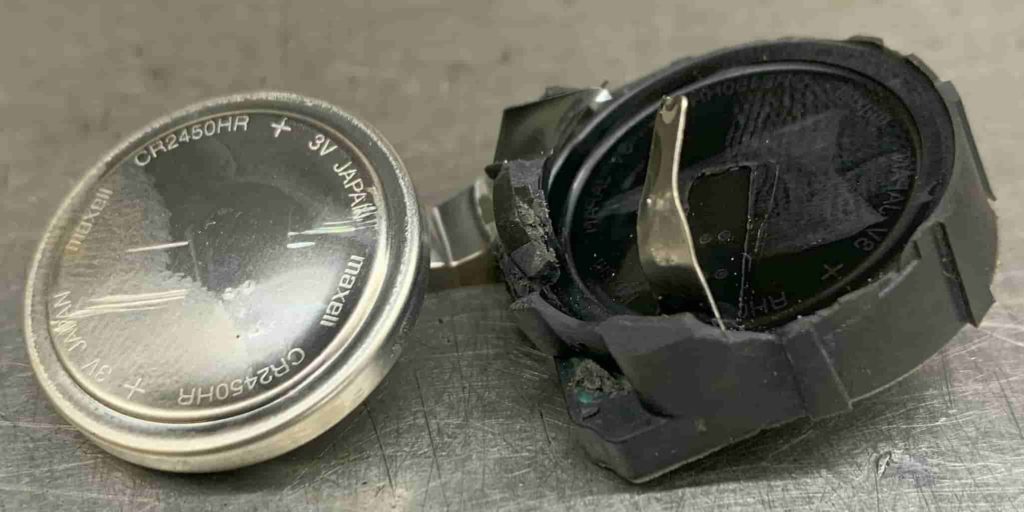What is a Tire Pressure Monitoring System
Imagine cruising down the highway when suddenly your tire blows out- scary, right? A tire pressure monitoring system (TPMS) is your BMW X2’s guardian angel, keeping tabs on your tire pressure 24/7. This life-saving feature not only protects you from surprise blowouts but also keeps your BMW running smoothly, saving fuel and extending your tire life. Don’t get caught off guard, let your TPMS be your silent ever-watchful protector!
How to Reset BMW X2 Tire Pressure Warning Light:
Select the MENU button under the shifter
Scroll over and select MY VEHICLE
Select VEHICLE STATUS
Select TIRE/TYRE SETTINGS
Select PERFORM RESET
How Does the BMW X2 Tire Pressure Monitoring Sensor System Work
The BMW X2 features a direct TPMS called the Tire Pressure Monitor (TPM).
The system has individual sensors in each wheel to directly measure tire pressure and tire temperature.
These sensors wirelessly transmit the tire pressure & temperature data to the vehicle’s onboard computer called the ECU or TPMS receiver module.
The computer compares the current tire pressure levels to the recommended range set by BMW.
If the pressure in any tire deviates from the recommended range, a tire warning light appears on the dashboard. Anymore more than 20% of the recommended tire pressure level will set off the tire pressure warning light.
Drivers can then address the issue by checking and adjusting tire pressure as needed
After resolving tire pressure discrepancies or performing tire-related maintenance, it’s important to reset the TPMS to ensure accurate monitoring. Follow the steps above to reset.
When Should You Reset the BMW X2 TPMS?
After adjusting tire pressure to the recommended level
After a tire rotation, wheel alignment, or tire balance
After replacing one or more tires
After installing new wheels or rims. TIP: Remember to swap old sensors into new wheels.
If the TPMS warning light stays on after inflating a tire to the correct pressure
After a seasonal tire swap (switching between winter and summer tires)
After any tire or wheel-related service or repair
After jump starting a dead battery or replacing the car’s battery
If a TPMS sensor is replaced or repaired
Why is the Tire Pressure Light on?
Common Causes for the Tire Light to Turn On:
Tire puncture or leak: A sharp object or road debris like a nail or screw may puncture a tire, causing air loss which will of course activate the warning light.
Vehicle weight overload: Too much weight on, in, or being towed by the vehicle.
Seasonal temperature changes: A drop in ambient temperature can cause tire pressure to decrease, triggering the warning light.
Faulty tire pressure sensor: Damaged or malfunctioning sensors may provide inaccurate readings, resulting in a false alert. The only way to determine which sensor is faulty is to scan each sensor with a TPMS diagnostic tool.
Valve stem issues: A damaged or leaking valve stem can lead to gradual pressure loss and eventual activation of the tire pressure light. They make kits to replace the rubber gasket that usually goes bad.
Tire damage: Impact from potholes or hitting a curb can cause structural damage like tire bubbles, leading to pressure loss.
Sensor battery life: TPMS sensors are battery-powered, and over time, batteries die. (they usually last anywhere from 5-10 years) This will cause the tire pressure light to turn on and flash.
Recent tire rotation or replacement: If the tires have been recently rotated or replaced, the TPMS may need recalibration to avoid false alerts. The vehicle’s computer may think the front tires are in the rear and rear in the front after a rotation.
Wheel issues: Damaged, corroded, or cracked wheels can lead to air leaks and pressure loss. This is very common with low profile tires.
Altitude changes: Climbing or descending in elevation can affect tire air pressure and trigger the TPMS warning. An additional 1.5 Psi per Km above sea level is required.
Natural pressure loss: Tires lose air pressure over time due to temperature changes and permeation. Tire dry-rot will happen to tires that sit.
Electrical problems or software issues within the car’s TPMS system. Occasionally the system may have a software update from BMW.
Snow Tires: If you have a separate pair of wheels for your snow tires, you can either transfer the sensors from your summer wheels or acquire an additional set of 4 sensors for the second pair of wheels. However, if you are using the same wheels for both sets of tires, there is no need to be concerned about this.
Why is the Tire Light Flashing?
Your BMW X2 has a special light to let you know if there is a problem with the Tire Pressure Monitoring System (TPMS), which is also called the TPMS malfunction light. This light is the same yellow exclamation mark as the regular tire pressure light, except its flashing. If the TPMS isn’t working properly, the light will flash for about a minute and then stay on. It will do this every time you start the car until you fix the problem. A flashing tire light usually means there’s a problem with the TPMS itself, not necessarily an air pressure issue.
What Can Cause a TPMS Malfunction?
Using non BMW X2 wheels or tires.
Certain electronic devices can send out signals that can interfere with the TPMS radio waves.
If your BMW X2 has dark window tints it can interfere with the communication between the vehicle’s computer and the tire pressure sensors.
If the tire pressure is extremely high.
Driving with the BMW spare tire on. (If your spare tire is a full size spare and not a donut, it has a sensor in it.)
If wheels without tire pressure sensors are installed on the car.
Extreme cold conditions such as snow or ice on the tire valve.
If the BMW X2 receiver module/ECU does not recognize newly installed tire pressure sensors.
Is It Safe to Drive When the Tire Light is On?
We strongly suggest not driving if your tire pressure warning light is on, as it could be unsafe. Figuring out why it’s on is really important. There might be something like a nail in your tire, or a leak somewhere. Is the tire losing air quickly or slowly? Finding out exactly what’s wrong will tell you if it’s safe to drive with the tire light on and for how long.
Why is My Tire Light On But My Tires Are Fine?
Your tire light might be on even when your tires look okay. Here’s why. First, make sure all tires including the spare have the right amount of air pressure. If they do, think about the weather. Did it change a lot recently? If your tire light turns off when you add air but comes back on when you drive, you have a leak. If your tires have the right pressure, aren’t losing air, but the light is still on, you likely have a faulty tire pressure sensor due to a dead battery.
Does the Weather Affect Tire Pressure?
Weather has a powerful impact on tire pressure in your BMW X2. As temperatures rise, so does the air pressure inside your tires. When temperatures drop, tire pressure decreases too. It’s like your tires are feeling the weather’s mood swings! So, keep an eye on your tire pressure during extreme weather changes to ensure optimal performance and safety. For every 10 degree (farenheit) change in temperature, your tire pressure will change in the same direction by about 1 PSI.
What Happens When Bmw Tires are Underinflated?
Driving a BMW X2 with underinflated tires can have several detrimental effects. Firstly, it can negatively impact your fuel efficiency because underinflated tires create more rolling resistance which means the engine has to work harder to keep the car moving. Secondly, it may compromise handling and braking performance potentially making your BMW X2 more difficult to steer or stop quickly. Additionally, tires that are consistently underinflated will wear out faster and unevenly leading to premature tire replacement. Lastly, underinflated tires will overheat quickly increasing the risk of a blowout especially during high-speed driving or long trips. Therefore, maintaining proper tire inflation in your BMW X2 is essential for both safety and optimal vehicle performance.
Tire Leaks and Solutions
How to Find the Source of a Tire Leak?
If you want to find a tire leak first check which tire has less air than it should. Add air to that tire because this method won’t work if the tire is fully flat. Next, mix soap and water (or use Windex) in a spray bottle and spray the whole tire with it. Make sure to spray extra on the bead area (where the tire touches the wheel) and the valve stem. Next, examine the tire for small bubbles. Wherever you see lots of tiny bubbles, that’s where the tire is leaking from. Be patient when looking for these bubbles. If the tire is losing air it definitely has a leak somewhere, so keep searching and you’ll find the leak.
Are Tire Plugs Safe?
Yes, tire plugs are safe! I’ve used them many times to fix punctures in the tread part of the tire. You stick them directly into the puncture which seals up the hole and stops air from leaking out. (Don’t forget to take out whatever made the hole to begin with, though.) Tire plugs are made from tough rubbery material that can handle the dramatic conditions inside a tire like changes in air pressure and temperature. If you put a tire plug in the right way, it should last as long as the tire does. But remember, don’t use tire plugs to fix the sidewall of a tire.
Are Tire Sealants Safe?
Tire sealants can help temporarily fix a flat tire in emergencies, but they’re not meant for long-term use. Be cautious as they can cause significant damage to your tire pressure sensors. The sealant can destroy the sensor’s electronic circuit board. Tire sealants can also disrupt the tire’s balance, causing strong vibrations in the steering wheel while driving. To avoid these issues it’s best to avoid using tire sealants unless absolutely necessary. If you do use one, make sure to take your BMW X2 to a tire repair shop as soon as possible.
How to Check and Adjust Tire Pressure
Gather the necessary tools: You’ll need a tire pressure gauge and an air compressor.
Park your BMW X2 on a level surface and engage the parking brake.
Locate the tire pressure specifications: Check the owner’s manual or the sticker on the driver’s side door jamb for the recommended tire pressure values.
Unscrew the valve caps from each tire.
Attach the tire pressure gauge to the valve stem and press firmly to get an accurate reading.
Compare the measured pressure with the recommended pressure. If it’s too low, continue to the next step.
Connect the air compressor to the valve stem and add air in short bursts.
Regularly check the tire pressure with the gauge to avoid overinflating.
Repeat the process for each tire, including the spare.
Once all tires are at the correct pressure, put the valve caps back on.
Verify the tire pressure one final time to ensure accuracy.
What to Do if Nothing Else Works
If your tire light won’t turn off, you may need to reset your BMW X2 computer. This involves disconnecting the main 12 volt battery for a few minutes. Always disconnect the negative terminal first to avoid short-circuits. You’ll need a 10 or 12mm wrench or socket for this. Disconnecting the battery clears all error codes from the Engine Control Unit (ECU), including the one causing the tire light to stay on. It also resets the computer’s memory which includes things like radio presets and seat settings. After reconnecting the battery your car will begin to re-calibrate its sensors. Complete this process by driving at 50 mph for at least 30 minutes after reconnecting the battery.
BMW Tire Pressure Sensor Batteries
Each tire pressure sensor has a sealed battery that powers it. It’s important to know that these batteries can’t be replaced. They look like wrist watch batteries and are directly attached to the sensor’s circuit board within the sensor’s plastic case. When the battery is depleted the whole sensor needs to be replaced. The battery’s lifespan can vary depending on things like how you drive and the weather. On average tire pressure sensor batteries last between 5 and 10 years.
TPMS Legal Considerations
Is it Required By Law to Have TPMS Sensors?
Yes, in many places around the world including the United States and Europe, it’s a legal requirement for vehicles to have tire pressure monitoring system sensors. In the U.S. the TREAD Act, passed in 2000 mandates that all vehicles built after September 2007 must be equipped with TPMS. This rule mainly applies to manufacturers and aims to improve road safety by alerting drivers to changes in tire pressure. Similarly, European directives from November 2012 state that all new passenger vehicles must have TPMS installed. These regulations are in place to reduce accidents caused by tire problems.
Will My BMW Pass State Inspection if the Tire Light is On?
In some states the tire pressure monitoring system (TPMS) is checked during a safety inspection. For instance, in New York and Texas, the TPMS is assessed as part of the inspection process but it doesn’t have any impact on the inspection result. As a licensed state inspector in New Jersey, I can confirm that having a functional TPMS in a passenger vehicle is not mandatory. Even if the tire pressure light is on the vehicle will still pass inspection. However, for commercial vehicles there may be different rules as they require full safety inspections. Due to the variation between states it’s recommended to consult your local Department of Motor Vehicles or relevant authorities for accurate information.
Please note that this blog post contains Amazon affiliate links. This means that if you make a purchase through one of these links, the author of the blog may earn a small commission at no extra cost to you. The author only recommends products that they personally use and believe in. Thank you for supporting this blog.







